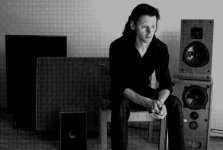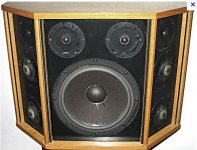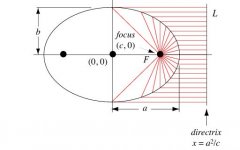Member
Joined 2009
Paid Member
Well if I go back and re-read a bit, I find that box colourations might be something we can define if we give it proper descriptions:
i) the driver directly couples sound to the box, or the sound waves from the driver couple to the box and you then get parasitic sound from vibrations of the box itself consisting of resonances and delayed release of stored energy. This one is really tough to address because box designs are usually a tradeoff between heavy & well damped (no resonances but lots of stored energy) or light & stiff (low stored energy but more resonances)
ii) sound emanating from the back of the driver which is then reflected from inside of the box and out through the cone. The reflected sound has a much shorter delay than is found in an OB because the distances are small and this results in smeared sound. This one is really tough to address because it's near impossible to find perfect wide-band absorbers.
iii) sound generated from the front of the driver which is diffracted/reflected from the baffle of the box and which occurs also with OB's. This one is a case of baffle shape and finishing and as far as I can see affects boxes and OBs.
did I miss anything ?
Seems to suggest that box colourations are hard to get rid of.
i) the driver directly couples sound to the box, or the sound waves from the driver couple to the box and you then get parasitic sound from vibrations of the box itself consisting of resonances and delayed release of stored energy. This one is really tough to address because box designs are usually a tradeoff between heavy & well damped (no resonances but lots of stored energy) or light & stiff (low stored energy but more resonances)
ii) sound emanating from the back of the driver which is then reflected from inside of the box and out through the cone. The reflected sound has a much shorter delay than is found in an OB because the distances are small and this results in smeared sound. This one is really tough to address because it's near impossible to find perfect wide-band absorbers.
iii) sound generated from the front of the driver which is diffracted/reflected from the baffle of the box and which occurs also with OB's. This one is a case of baffle shape and finishing and as far as I can see affects boxes and OBs.
did I miss anything ?
Seems to suggest that box colourations are hard to get rid of.
Boxiness
Cal this isn't about you. It's about the usual suspects taking up their lances and jousting. Personally I can't see how any driver mounting scheme will not have a sonic characteristic. And I notice Dave D hasn't weighed in.
Cal this isn't about you. It's about the usual suspects taking up their lances and jousting. Personally I can't see how any driver mounting scheme will not have a sonic characteristic. And I notice Dave D hasn't weighed in.
And I notice Dave D hasn't weighed in.
😀
I'll listen too it and tell you whether i think it is "boxy". My efforts to avoid boxiness are what got me where i am now.
I used to libe with ESLs.
dave
Personally I can't see how any driver mounting scheme will not have a sonic characteristic. And I notice Dave D hasn't weighed in.
planet10 said:My efforts to avoid boxiness are what got me where i am now.
Isn't the point being made simply come down to: even a very well done box still won't sound like OB?
The very well done boxes i have done sound better to me than any OB i have heard or built.
dave
dave
.. but it's still a box. I'm not comparing bad/good better/worse ... OB and the box(s) sound different. The box colors the sound. Take the back off the box and it sounds different.The very well done boxes i have done sound better to me than any OB i have heard or built.
dave
Sort of comes down to what a person prefers ... doesn't it?
In what way? We are talking about a naked driver on a baffle or maybe not on a baffle .. right?An OB colours the sound too.
dave
The box colors the sound. Take the back off the box and it sounds different.
Sort of comes down to what a person prefers ... doesn't it?
But does it? Say a closed box increases the Q of the response rolloff. Assume that cabinet walls and the back wave have been fixed. The faster rolloff will probably sound worse if you listen to it in isolation. Find the complementary rolloff in the next driver and it shouldn't sound wrong anymore.
In what way? We are talking about a naked driver on a baffle or maybe not on a baffle .. right?
Ignoring room interation...
The only colouration an OB is not subject tom that a box are those the box's cavity presents, and that only in a flat baffle. Any OB with wings (U/H/etc) will have its on cavity resonances.
It is a lot harder to get the "enclosure" resonances out of a flat baffle as it is inherently weaker.
And OBs have distortion/colourations a box doesn't. Check out Michael G's paper on the CMP distortion inherent in an OB. Audio and Loudspeaker Design Guide Lines
As well the dipole roll-off of 6 dB/octave will also inherently degrade DDR at the same 6 dB/octave.
Even the best speakers are poor compared to what they'd need to be to be perfect -- you have to pick your compromises.
dave
Hi AllenB ... I'm not really making any assertion as to wrong/right sound(ing). All I'm saying is that the box colors the sound in its own way.
If I take the back off of one of Daves fine loudspeakers .. it will sound different. Replacing the back of the cabinet produces another result in sound quality. I should be able to say, then, that the box colors the sound.
Is this too simplistic?
If I take the back off of one of Daves fine loudspeakers .. it will sound different. Replacing the back of the cabinet produces another result in sound quality. I should be able to say, then, that the box colors the sound.
Is this too simplistic?
It is too simplistic.
If you take the back off it will have no bass, but it will still have a cavity resonance -- but of different sort (and likely more audible because there is no back).
dave
If you take the back off it will have no bass, but it will still have a cavity resonance -- but of different sort (and likely more audible because there is no back).
dave
It is too simplistic.
If you take the back off it will have no bass, but it will still have a cavity resonance -- but of different sort (and likely more audible because there is no back).
And some:
It will have a completely different radiation pattern for all drivers, which radiate to the back too.
It will have a different frequency response for all drivers, which radiate to the back too - not only in the bass region.
And some will argue that you will hear the doubled edge diffraction too.
...and there could be a backwave (a back backwave 😉) related to the distance to the opening at the back. Those rearward waves will also cause reflections from the back wall.
Member
Joined 2009
Paid Member
A Blameless speaker box ?
So what makes a good speaker box for minimal coloration beyond that which I have gleaned over the past year or so ?
(perhaps some of the tricks are to be kept as secrets...)
Use high quality ply and well braced for stiffness that pushes resonances as high as possible - I'm in the 'low storage energy' camp.
Avoid parallel walls, add wall treatments, maybe those nice wooden blocks people use for HT rooms could be scaled down and used inside the box ?
Aim for golden ratio of box dimensions (use irrational numbers to avoid coincident tuned modes)
Don't crowd the back of the driver, especially keep any internal walls or back panels away from the driver that would reflect sound straight back out again
Bracing / support for driver magnet
Add felt lining
Reduce baffle edge diffraction with sizeable round-overs
Damping - are there low-energy storage damping materials ?
Onken ports / resistive ports / aperiodic alignment - reduces Q of port resonance
So what makes a good speaker box for minimal coloration beyond that which I have gleaned over the past year or so ?
(perhaps some of the tricks are to be kept as secrets...)
Use high quality ply and well braced for stiffness that pushes resonances as high as possible - I'm in the 'low storage energy' camp.
Avoid parallel walls, add wall treatments, maybe those nice wooden blocks people use for HT rooms could be scaled down and used inside the box ?
Aim for golden ratio of box dimensions (use irrational numbers to avoid coincident tuned modes)
Don't crowd the back of the driver, especially keep any internal walls or back panels away from the driver that would reflect sound straight back out again
Bracing / support for driver magnet
Add felt lining
Reduce baffle edge diffraction with sizeable round-overs
Damping - are there low-energy storage damping materials ?
Onken ports / resistive ports / aperiodic alignment - reduces Q of port resonance
Last edited:
If a backwave is going to return to the cone, it will either way. The delays and response bias' could be better or worse.Avoid parallel walls,
I do think Bigun is asking the RIGHT QUESTION here in going for a BLAMELESS loudspeaker box. Standmounters are problematic, so lets go for wall mounted bookshelf types.
My feeling is you can get rid of all the diffraction problems by mounting the box in a flat wall. Lets suppose the wall is a piece of granite, just because it's about the toughest most inert material I can think of. We might compromise with brick. 😀
Golden ratio (approx 5:8:13 cabinet dimensions) is right for sure, because that spreads coincidence up to the 5th harmonic if you do the math. No cabinet or diffraction problems to worry about.
I'd guess all you then need is some evenly distributed stuffing to kill off the resonances. I might question whether the box or cavity behind the driver would better be some sort of flattened egg shape. Elliptical at heart. It could even be a horn or transmission line facing the outside world behind the speaker. You the listener would of course be ignorant of what is in the wall or behind it. You'd just see the driver mounted in a flat wall in your room.
Did anyone mention that low inductance and small drivers makes life much easier with crossovers. Time alignment good too. 3 way even easier. And don't forget to apply similar damping to your room as you do the speaker cabinet. 😎
Enclose some random images to keep us thinking.
My feeling is you can get rid of all the diffraction problems by mounting the box in a flat wall. Lets suppose the wall is a piece of granite, just because it's about the toughest most inert material I can think of. We might compromise with brick. 😀
Golden ratio (approx 5:8:13 cabinet dimensions) is right for sure, because that spreads coincidence up to the 5th harmonic if you do the math. No cabinet or diffraction problems to worry about.
I'd guess all you then need is some evenly distributed stuffing to kill off the resonances. I might question whether the box or cavity behind the driver would better be some sort of flattened egg shape. Elliptical at heart. It could even be a horn or transmission line facing the outside world behind the speaker. You the listener would of course be ignorant of what is in the wall or behind it. You'd just see the driver mounted in a flat wall in your room.
Did anyone mention that low inductance and small drivers makes life much easier with crossovers. Time alignment good too. 3 way even easier. And don't forget to apply similar damping to your room as you do the speaker cabinet. 😎
Enclose some random images to keep us thinking.
Attachments
Last edited:
Dipoles can be built using two opposite firing box speakers.
So having equalised them equally, one can 'hear' what the box contribution is.
So having equalised them equally, one can 'hear' what the box contribution is.
I usually say that I have spent a life-time matching subwoofers to dipole speakers.
I had a very nice pair of Quad ELS 57's, and it was a big challenge to match the sound of subwoofers to the characteristics of this dipole classic.
My conclusion is (and has been for many years) that at low frequencies you cannot hear the box (and I have had sand-filled subwoofer-boxes), but you can certainly hear if you are trying to match a monpole to a dipole.
In other words: if the subs were made to have the same way of exiting room modes as the dipole (in this case the ELS 57) nobody could here the sub's.
I used twin subs, 3 or 4 drivers per side, runnig from floor to ceiling, thus cancelling a lot of room-modes, exactly the way a dipole does.
So: dipoles are great because there is no box to color the sound, but they are ALSO great because they do not exite the modes (or just a few) in the BIG BOX.
A loudspeaker in a listening room is a normally a small box in a big box.
Steen
I had a very nice pair of Quad ELS 57's, and it was a big challenge to match the sound of subwoofers to the characteristics of this dipole classic.
My conclusion is (and has been for many years) that at low frequencies you cannot hear the box (and I have had sand-filled subwoofer-boxes), but you can certainly hear if you are trying to match a monpole to a dipole.
In other words: if the subs were made to have the same way of exiting room modes as the dipole (in this case the ELS 57) nobody could here the sub's.
I used twin subs, 3 or 4 drivers per side, runnig from floor to ceiling, thus cancelling a lot of room-modes, exactly the way a dipole does.
So: dipoles are great because there is no box to color the sound, but they are ALSO great because they do not exite the modes (or just a few) in the BIG BOX.
A loudspeaker in a listening room is a normally a small box in a big box.
Steen
Don't forget that Quads also have little bass output.
There's not much documentation that says dipoles trigger less rom modes then monopoles. With optimal placement (important) they seem to do somewhat better. Cardoide dispersion seem to be less sensitive to placement. But again; the documentation on this is very limited to my knowledge.
There's not much documentation that says dipoles trigger less rom modes then monopoles. With optimal placement (important) they seem to do somewhat better. Cardoide dispersion seem to be less sensitive to placement. But again; the documentation on this is very limited to my knowledge.
- Home
- Loudspeakers
- Multi-Way
- Box colourations - really ?


